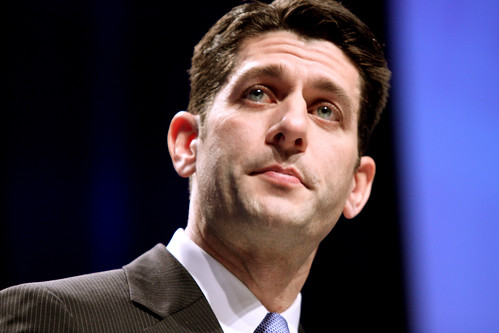5. Rep. Paul Ryan and the House would make deep cuts in spending, in large part by reducing programs for low-income families
Rep. Ryan proposes $5.7 trillion in spending cuts to be implemented over 10 years. Similar to his budget last year, these cuts target programs that benefit low-income families: Medicaid, food stamps, and Pell Grants are among those slated for cuts. Discretionary spending – which includes general education programs and safety-net measures like the WIC nutrition program for women and children – would also see cuts in Rep. Ryan's plan to balance the budget in 10 years. Such cuts are unlikely to become law as they will not win approval from the Democratically-controlled Senate and President Obama.
4. The Congressional Progressive Caucus would raise trillions of dollars in new taxes from the wealthiest Americans and corporations
New tax brackets for millionaires and billionaires and the closing of numerous tax loopholes are central to the long-term budget blueprint put out by the Congressional Progressive Caucus (CPC). The budget would also impose a "Wall Street" tax on financial transactions. This proposal for new taxes allows the CPC to add substantial new spending on job creation and still reduce deficits by $2.7 trillion over 10 years. But this amount of revenue could not pass the Republican-controlled House – where lawmakers decry any new taxes – and will have trouble winning approval from many Democrats as well.
3. Budget Chair Patty Murray and the Senate propose a mix of spending cuts and tax increases
While Rep. Ryan makes huge spending cuts and the CPC raised substantial new tax revenue, Sen. Patty Murray did a little bit of each one. Her budget would add around $923 billion in new tax revenue over a decade by limiting tax deductions for the wealthy and closing some tax loopholes for corporations. It would also cut around $837 billion from spending over the same time period, including $240 billion in reductions to the military budget.
2. All three budgets would end the growth in military spending that has occurred over the past decade
Since 2002 U.S. military spending increased by nearly 50 percent. The budget proposals introduced in Congress this week represent a major shift in thinking about funding for the Pentagon. While Rep. Ryan's budget would spare the Pentagon from the sequestration cuts that are currently in place, he does not propose growing the Pentagon's budget in future. And the Senate and House progressives propose cuts to military funding.
1. The budgets differ about whether deficit reduction should be a central goal
For Rep. Ryan and the House, deficit reduction is a major goal, while the CPC made job creation the centerpiece – something reflected in its title, "Back to Work." Again, Senate Democrats did a little bit of both – some new spending on job creation and job training initiatives and some deficit reduction. But together these budgets indicate that there's no clear consensus that deficit reduction should be the central goal. Indeed, while 72 percent of Americans listed deficits as a top priority, some 95 percent said the same about restoring the job market.
See a side-by-side analysis of these three budgets – plus a comparison to what Americans want – here.
Photo by Gage Skidmore/ Creative Commons



The views and opinions expressed in this post are those of the author(s) and do not necessarily reflect those of MomsRising.org.
MomsRising.org strongly encourages our readers to post comments in response to blog posts. We value diversity of opinions and perspectives. Our goals for this space are to be educational, thought-provoking, and respectful. So we actively moderate comments and we reserve the right to edit or remove comments that undermine these goals. Thanks!